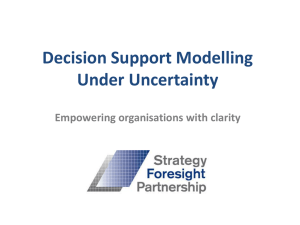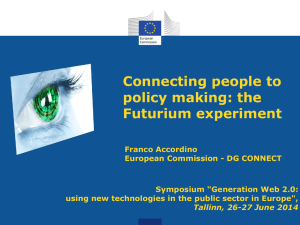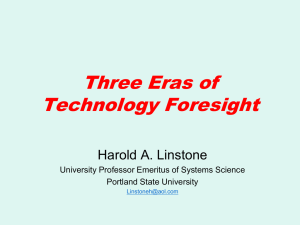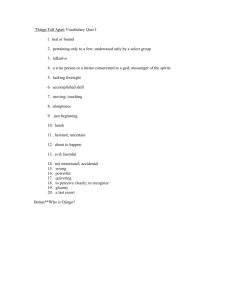Longer version
advertisement
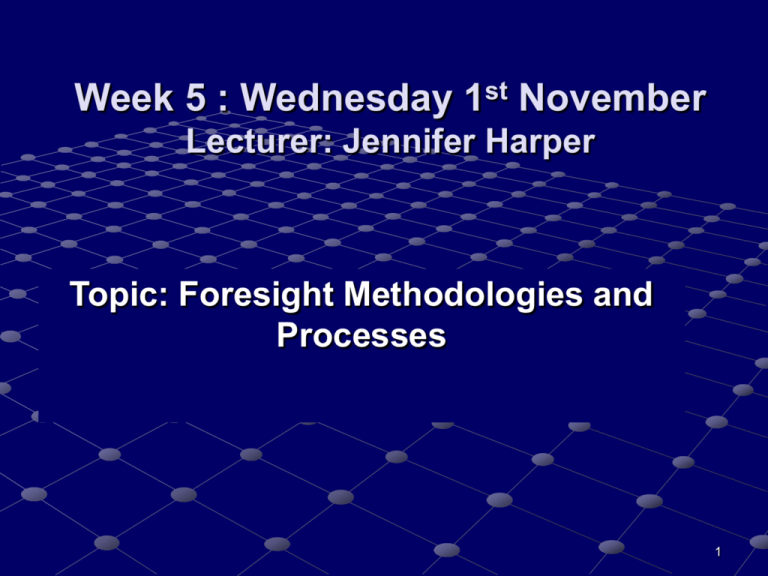
Week 5 : Wednesday 1st November Lecturer: Jennifer Harper Topic: Foresight Methodologies and Processes 1 Outline Introduction Clustering of Methods by Task Categories of Methods Foresight and Forecasting Methodologies Methods by Phases Quantitative Qualitative Exploratory vs Normative Other methods 2 Introduction Foresight methods and processes draw on futures, planning and networking approaches. EU-US approaches differ : EU more fragmented and diverse as are the methods used Identify the strengths & weaknesses of the different approaches and address the concerns Ensure appropriate use of methods/ Combined use of methods recommended. Choice and combination of methods have important implications in terms of process, results and policy impacts Ethical concerns: exploratory/creative vs. normative, top-down In-built paradox: predicted futures vs invented/created futures; adaptive change and the self-fulfilling prophesy 3 Clustering of Methods by Task 1. Methods to manage foresight ROAME (Rationale, Objectives, Activities, Monitoring and Evaluation) Set systems to document the process + outputs - The structures – steering committee 2. Pre-Foresight Methods Scoping Identifying stakeholders – co-nomination SWOT Benchmarking Environmental Scanning Adapted from Miles 2002 4 Clustering by Task 3. Foresight Generation Genius forecasting, Expert panels, Brainstorming, Mindmapping Relevance trees, cross-impact analysis, delphi, scenarios, trend extrapolation… Key technologies 4. Foresight action and renewal Action Plans, Demonstrators, Panel Embedding, Publications, Outreach Adapted from Miles 2002 5 Categories by Criteria Methods Quantitative methods (use of statistics and other data) to elaborate future trends and impacts − Trend extrapolation − Simulation modelling − Cross impact analysis − System dynamics Qualitative methods (drawing on expert knowledge) to develop long term strategies − Delphi method − Experts panels − Brainstorming − Mindmapping − Scenario analysis workshops − SWOT analysis Methods to identify key points of action to determine planning strategies − Critical/ key technologies − Relevance trees − Morphological analysis Source: FOREN Guide 6 Categories of Methods Quantitative methods provide numerical representation of future developments, e.g. forecasts and modelling. They give a great deal of weight, an ability to examine rates and scales of changes but they limit the comprehension of social and political variables and are not always reliable. Qualitative methods vary from creative thinking to more systematic techniques. Used when data are hard to collect or not available. Foresight can never be completely dominated by quantitative methods: the mix depends on access to relevant expertise and the nature of the issues. Source: Foren Guide 7 Categories of Methods Exploratory methods (“outward bound”) start from the present and move forward to examine kinds of alternative future developments it can lead to. Look at implications of possible developments that lie outside familiar trends: What if methods Normative methods (“inward bound”) start with the creation of a preliminary view of possible (preferred) futures, then an analysis of how these futures may grow out of the present asking what trends and events would take us there or can be avoided. How methods. Source: Foren Guide 8 Foresight and forecasting methodologies Forecasting 3 processes of precedent, analogy and extrapolation that gather material by looking back/backcasting based on the assumption of a stable world where tomorrow will be different from today just as today was different from yesterday, but that the same things always change in the same way at the same rate, following some immutable law, or demographic change. Foresight More qualitative methods based on eliciting expert knowledge. Shift from refined sectoral forecasts “better to sweep wide and large to glean the macro-trends than to forge highly sophisticated tools for segments of realities, which generate quantitatively precise forecasts that are generally wrong because they skip over discontinuities”. 9 Foresight and forecasting methodologies Forecasting main tools: Traditional methods of extrapolation. econometric model based on mechanics and transposed to microeconomics and then macroeconomics. Simulation modelling Cross impact analysis System dynamics Foresight Main tools: Delphi method Expert panels Brainstorming Mindmapping Scenario analysis and building SWOT Critical technologies Relevance trees 10 Methods by Phases 1. 2. 3. 4. 5. Define the problem:specific challenges and needs, e.g. a longer-term innovation strategy), set the time horizon. Methods: Panels, SWOT or brain-storming, Scope -possible focus on specific sectors, bottom-up vs top-down, extent and structure of consultation (experts/non-experts), resources, choosing appropriate methods. Identify the key variables analyzing the relations between variables, by placing them in matrix to identify drivers. Methods: panels/ interviews/desk-based research/ specialized studies/ cross-impact analysis: influence and dependency graph. Gathering data on trends and drafting hypotheses. Methods: trend analysis, simulation modeling, weak signals. Exploring possible future through scenario-building Methods: Exploratory or Normative approaches, panels 11 Scoping for a regional exercise What are the possible futures of the region in terms of strengths and weaknesses? What sectors, technologies and industries should be promoted to enhance competitiveness? What are the likely prospects for regionally important markets in general? What are the likely changes affecting the market important to a specific regionally significant industry? What are the likely development trends in central social issues? Source: FOR-RIS Report 2004 http://europa.eu.int/comm/research/conferences/2004/foresight/pdf/for-ris_en.pdf#zoom=100 12 Quantitative Methods Forecasting (time series analysis) Trend Extrapolation (long-term vs short-term Cross Impact Analysis Simulation Modeling System Dynamics 13 Time series analysis Assumption: inherent laws in economic activity (quantified through past analysis) these laws steer the development of economically relevant variables onto certain ‘predestined’ courses and enable visualization of future development. Breakdown of a time series into its components: trend typical seasonal but still short-term fluctuations, business cycle irregular influences Short-term vs long-term (UK’s growth rate round 2% since 1860) Heavy trends vs seed events (weak signals 9/11) Source: Hans Georg Graf 14 Types of trends Linear Trend increases/decreases over time at constant absolute rates of change. Exponential Trend increases/decreases at constant percentage rates of growth Parabolic trend has the tendency of initially increasing or decreasing only slightly and then more and more so with time. Logistic Curves, Growth Curves are usually S-shaped, i.e., moving from an initial phase into a dynamic phase in order to then enter into a new (stationary) equilibrium phase again in the end. Life Cycle Curves follow at first a growth curve trend. In a subsequent period the curve takes a downturn again. forecasts are based on extrapolations of past trends. Best fit - based on analysed series of numbers, ‘typical’ trend or ‘trend of the best fit’ is extrapolated into the future by assuming that the relationships so expressed remain the same and continue to exist in the same form in the future. Source: Hans Georg Graf 15 16 Trend Extrapolation The basis of extrapolation is to locate a trend that is apparent over time, and project forward data re the rates of change and the extent of change achieved. In the shorter-term forecasts this is often a matter of extending a linear or exponential curve – e.g. economic growth, power or diffusion of a technology. In the longer-term, limits to growth will often be encountered – there may be a limit to the size of the population to whom a technology or cultural practice can diffuse for example, and various other types of trend curve may be fitted to the data (e.g. S-curve). Adapted from Hans Georg Graf 17 Concerns with trend analysis Superficial dichotomy of past as knowable unquestionable facts and future as arbitrary opinion. Past is open to re-interpretation. How reliable is trend data? Limited historical data or trends guessed at. How to find link between variables? GDP/employment by rate/volume. Time sequences: the fertility rate in Fr over past two centuries offers diametrically opposed trends depending on time sequence chosen. Persistence of underlying driving forces? Will counter-trends come into play, e.g. as resistance grows to a particular cultural development, or competitors learn to challenge the power behind a trend? Adapted from Hans Georg Graf 18 Concerns with trend analysis At what point will ceilings or turning points be reached? A key challenge is estimating the ceiling in diffusion of technologies or practices, e.g. level at which the population is saturated with this new product. Infant mortality as indicator of progress in life expectancy (ceiling). Is the quantitative trend masking qualitative change? E.g. new technologies diffuse, but also change, e.g. computers, cultural practices, diseases: implications of later adoption of the new product or practice are liable to be very different from those of the early adoption. The skills required, the cultural meaning are all liable to have changed. Adapted from: Hans Georg Graf 19 Perceptions and misperceptions Our view of reality depends on: Our lens/blinkers (partial/blurred vision) Mindsets, mental constructs, emotion, bias Our means of observation and knowledge sources available to us The means of measurement (GDP) The weight of the theories we use The influence of ideologies /schools of thought Source:Blueprints Report 20 Source: Hans Georg Graf 21 Cross Impact Analysis An expert-based and quantitative method used in preparation of scenarios, for establishing the drivers and likely events. Experts rate the likelihood of various events occurring or not occurring. The matrix of possibilities that arises from this can be subject to mathematical analysis to generate a list of scenarios, each with an aggregate probability of occurrence assigned to it. The cross-impact method forces attention to chains of causality: ‘x’ affects ‘y’; ‘y’ affects ‘z’ Source: FOREN Guide 22 Utility of Cross-Impact Analysis According to William Alexander, Cross-Impact Analysis assesses the validity and accuracy of a vision through a systemic approach: Breaking vision down into specific “themes” & “events” Revealing interdependencies among themes and events Determining the probabilities of the relative impact interrelationships may have on each other Calculating an overall “matrix index” that provides a measure of the projected strength and influences of the event interrelationships and their likelihood of bringing about the 23 strategic future Cross Impact Matrix How does this affect this Top executives of highprofile corporations employ deceptive practices to rob shareholders and other stakeholders. The forces of economic globalization make national borders permeable to commerce and enable free trade. Americans tend to value decentralized government. Permeable borders and free trade create more opportunities for deceptive business practices. Decentralized government weakens federal regulatory power and creates a divide and conquer phenomenon (corporations can seek the weakest local regulatory environments). Top executives of highprofile corporations employ deceptive practices to rob shareholders and other stakeholders. The forces of economic globalization make national borders permeable to commerce and enable free trade. Corporate malfeasance could make lawmakers wary and incline them to impose barriers to international commerce. Americans tend to value decentralized government. There may be more demand for centralized federal control of business practices. American support for decentralized government will promote laissez-faire trade while accelerating trends toward globalization. Free trade is compatible with decentralized government so freetrade advocates will press for more decentralization. http://ghost.rider.edu/cii/presen/matrix.doc 24 Concerns with Cross Impact Analysis The definition of events to be included in the study can be a tiring and tedious process but is a crucial step in a cross-impact analysis. Any influences not included in the event set, will be completely excluded from the study. However, the inclusion of events that are not pertinent can complicate the analysis unnecessarily. Limited use as only suitable for small sets of variables and very time-consuming for experts. Limited independent analysis of its utility. Source: FOREN Guide 25 Simulation Modeling Modelling : both computer simulations and role-playing. Computer simulations tend to be complex, representing a system in terms of a range of variables and their interrelationships. Large, all purpose vs simple issue-focused models Equilibrium vs dynamic process-based models Modelling has been most developed around relatively easily quantifiable issues, e.g. economic growth, employment, energy use, and demographics. In recent years important modelling efforts have been undertaken in examining climate change and environmental impacts. Modelling social, political and cultural change is much more contentious. Source: FOREN Guide 26 Concerns with Modeling Who validates the data and relationships assumed? dependent experts able to assess the quality of the modelling effort? Can key assumptions be debated, even by non-experts? Is the model over complex? Can it be made less costly to run, in terms of computer and labour resources? Is the model able to cope with structural or qualitative changes on the horizon? Does it address future developments within its framework? Are the results dictated by the assumptions made? Does the model assume that an equilibrium state is to be reached? If so, is this remotely realistic ? Source: FOREN Guide 27 Qualitative Methods Delphi Expert panels Brainstorming Mindmapping Scenario analysis and building SWOT Critical technologies Relevance trees 28 Delphi Delphi technique is a method used to reach consensus in groups. Its advantage is that it avoids group situations which are often prone to control by individuals that have the best group interaction and persuasion skills. This method overcomes problems of face-toface confrontation in the group, by keeping the responses and respondents anonymous. Delphi method produces a rapid narrowing of opinions and provides more accurate forecasts than group discussions. 29 The Delphi Project The Delphi Method Produces a Consensus-Based Response Among the first group processes, developed by RAND researchers in 50s to amalgamate expertise from a wide range of knowledge areas and divergent views to achieve eventual consensus. Delphi process is iterative - in successive rounds, a group of experts is asked to supply responses to a list of questions. At the conclusion of every round, the participants view each other’s answers and may then change their views in light of what others believe. The answers are presented anonymously to eliminate the possibility that undue weight will be placed on the responses of persons who hold particularly high status within the group. http://www.rand.org/publications/MR/MR1626/MR1626.ch2.pdf 30 Chronology of delphi activity Source: http://www.unido.org/file-storage/download/?file_id=16959 31 The Delphi Process 32 Organising a Delphi Deciding if it is appropriate method Defining the objectives (a process that may require use of other methods like creativity procedures or scenarios or future workshops) Setting up of expert panels (virtual?) Shift to use of On-line delphi, e.g. Euforia and Fistera projects Formulating the statements Structuring the fields and defining the topics (mix of desk-based research and creativity methods, brain-storming) Setting of criteria: estimated time of realisation (normal time horizon of delphi 30 years), level of expertise, which country is leader in this field, which policy measures should be taken? Also open questions. In designing the questionnaire, need to consider how to give feedback to experts in second round and also final presentation of data to clients. Constraints: complex logistics, time and resource intensive Source: FOREN Guide 33 Delphi Results: Measures and topic clusters Source: Kuhls, 2001 34 Concerns about Delphi Dependency on opinion of selected experts Level of expertise difficult to assess Poor execution leads to poor results Results may be manipulated to produce desired results in the second round Good for single issues but poor on considering issues within a holistic context (this is where cross-impact analysis is important) – less useful on complex forecasts based on multiple factors Framing of statements subject to cultural and social bias Source: FOREN Guide 35 Brainstorming Step1 : a period of freethinking for articulation of ideas. Step 2: collation of ideas and spin-off ideas. Not normally subject to critique or further analysis once a sufficient number generated. This reduces inhibitions to consider “wild” ideas. Step 3: ideas are grouped and prioritised and taken as the basis for more analytic discussion. Widely used technique for expert committees and consultation management groups. Several computer systems are now available as alternatives to the traditional use of whiteboards and flipcharts to record and display the ideas. Source: FOREN Guide 36 Mindmapping • Technique applied to brainstorming and other group discussion methods – useful for mapping relationships between a large number of factors • quick charting of group’s ideas in logical groupings, even when ideas emerge nonsequentially • allows efficient brainstorming for ideas, and at the same time create a skeletal framework for later categorisation of the information generated. • Mindmapping can be used in planning, identifying customer groups. Mindmapping works well when issues have many components and subcomponents. This technique is a nonSource: FOREN linear wayGuide of outlining information. 37 Scenarios A scenario is 'the description of a possible future and the corresponding path to it' (Godet) Godet presents 5 basic attitudes to the future: 1. the “passive” ostrich (go with the flow) 2. the “reactive” firefighter (damage reduction) 3. the “preactive” insurer(accident prevention) 4. the “proactive” innovative conspirator (innovators) 5. the “anticipative” actor (blend of 2,3 &4) Theser scenarios are normative, describing preferred alternatives. Shift from trend-based scenarios to scenarios depicting deep breaks or even breakdown in current 38 trends Scenarios Exploratory (outward) Moving from present to the future What next? What if? Normative (inward) Moving from future back to the present Where to? How to? 39 Building scenarios 40 Concerns in Scenario Analysis Superior to many other methods where number of factors to be considered and the degree of uncertainty are high Stimulates strategic thinking, communication and organisational agility Difficult to draw up credible and useful scenarios Users might find it difficult to deal with multiple images of plausible futures May be mistaken for forecasts 41 SWOT Strengths, Weaknesses, Opportunities, Threats Used in Scenario workshops and Delphi Focus on the current situation Prepared by an expert team based on evidence drawn from interviews, statistical or benchmarking Assessment can be presented in 2x2 matrix Strengths Weaknesses Opportunities Threats Main internal and external factors influencing strategies (or possible futures)in positive or negative ways. S: internal positive factors O: external positive factors W: internal negative factors T: external negative factors http://www.quickmba.com/strategy/swot/ 42 Critical Technologies What are critical technologies? Related to national self-sufficiency generic and pre-competitive High potential of various product applications. How to identify list of critical technologies? Apply criteria to measure importance of certain technologies – clarity and consistency!! Interviews, benchmarking, brainstorming, panels, bibliometrics Indicate points of policy intervention Setting the Criteria: Be clear on what constitutes ‘critical” capabilities vs needs, technology push vs supply or needs driven. Adapted from Foren Guide 43 ‘Importance’ Set of criteria used to assess importance & feasibility. Each criteria to be assigned a mark from the scale 1-5 (1 = low; 5 = extremely high) Economic Importance Social Importance Environmental Importance Importance for GDP Importance for human health Impact on material effectiveness Importance for Export Importance for the safety of society Impact on energy effectiveness Impact on productivity Impact/influence on the quality of life Environmental-friendly effect Market size Influence on the creation of job opport. Potential of replacing non-renewable energy by renewable ones Strategic importance for CR internationally Natural and productive space saving effect Effect on transport requirements 44 ‘Importance’ Research & technological opportunities Ability of the R direction to produce new technologies Probability of ‘breakthrough discoveries’ Probability of creation of new application possibilities related to the R direction Possibility of combining the R direction with other R directions Possibility of applying the results of the R direction in various applications Probability of a synergic effect with other research directions Probability of involvement in international Importance for meeting untackled needs of the society 45 ‘Feasibility’ Application potential (absorption potential of the application sector) Research and technology potential (production potential of R&D) Competitiveness of the application Current state of the art of the sector (s) research field Support in admin/state policy and regulation Probability of a positive development of the research field Availability of results in the world market Level of necessary R & infrastructure Demand of the application sector Financial reqmnts of the research direction Probability of financing from various sources Level of education in related fields Current quality of human resources Czech foresight https://www.unido.org/file-storage/download/?file_id=16961 46 Influence on the creation and growth potential of SMEs Relevance Trees and Morphological Analysis • Best-known normative forecasting methods • Used to identify the circumstances, capabilities, actions and knowledge to achieve future objectives • Relevance trees sub-divide topic into sub-topics in a tree-like structure, to map various aspects of a system, a problem or solutions. • Morphological Analysis maps all possible solutions to a problem to determine alternative futures, e.g. product development or building scenarios. • These approaches are time-consuming as they require in-depth analysis and multi-disciplinary expertise. Adapted from Miles 2002 47 Horizon Scanning Horizon scanning is defined as the systematic examination of potential threats, opportunities and likely future developments, including (but not restricted to) those at the margins of current thinking and planning. Horizon scanning may explore novel and unexpected issues as well as persistent problems or trends. UK Chief Scientific Adviser’s Committee, September 2004 […] excellent horizon-scanning of current science and technology, looking at opportunities and threats at least five to ten years ahead, and often considerably beyond that, is essential to the effective governance and direction of Government policy, publicly funded research and many of the activities of the private sector, and to the interactions between them UK Science & innovation investment framework 20042014 48 Environmental scanning Environment refers not just to natural environment – business, political, technology. Approaches for identifying important future developments in the environment of organisations: Why: trend-spotting: in fashion, tastes, key players How: issue surveys based on polling experts. “genius forecasting” experts write about topics that they believe will be important for the future. systematic analysis of documentary sources, e.g. press coverage or web searches means to chart emergence of key themes. bibliometrics and patent analysis Concern: Lock-in to particular sources/methods http://horizon.unc.edu/projects/seminars/futuresresearch/stages.asp http://www.tukkk.fi/tutu/vanhat/scanning2003/papers/jkaivooja.pdf 49 Criteria for selecting methods Organisational context Nature of issue(s) under consideration Quantitative/Qualitative data requirements Time horizon Methodological competence Process/Product balance Suitability for combining with other methods Suitability for visualising the results Source: Scapolo (EFA) 2003 50 For discussion The ethics of forecasting and foresight depends on the choice and combination of methods used. The balance between predicted futures and created futures is a reflection of sociocultural context and local competencies in use of futures methods. 51 Topics for Individual assignments Assignments are to be handed in by end of January. Topics that can be addressed apart from set questions at the end of lecture: Evaluation or impact assessment of a major foresight activity Effective engagement /outreach to policy-makers and society Emerging themes in foresight like ethical issues, systemic and/or adaptive foresight, Higher Education or university foresight, regional foresight, Emerging tools: disruption scenarios, success scenarios, on-line approaches and horizon scanning. 52 References FOREN GUIDE http://forera.jrc.es/documents/eur20128en.pdf Hans Georg Graf http://www.unido.org/file-storage/download/?file_id=16949 http://forera.jrc.es/fta/intro.html http://www.efmn.info http://cordis.europa.eu/foresight/home.htm http://www.eranet-forsociety.net/ForSociety http://www.costa22.org/ http://forlearn.jrc.es/index.htm http://www.unido.org/doc/12296 http://www.futurreg.net/ 53
